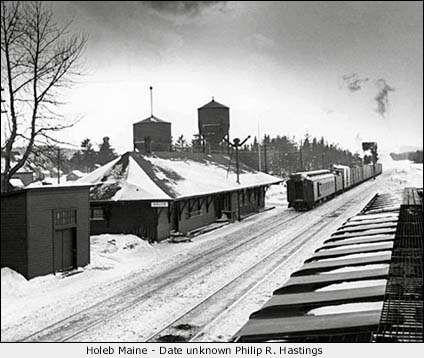Vol. 17 No. 9
September, 1987
|
Stay Safe in 87
|
|

Ceremony Absent
at Short
Line's Completion
|

Omer Lavallee
|

Continuing our historical summary of
the building of the "International of Maine", by mid-September, 1888, the track was completed,
many stations built, and mixed train service in operation between Megantic, Quebec, and Greenville, Maine, a distance
of 136 kilometres.
According to the reminiscences of a pioneer locomotive engineer, Charles Small, this train was usually handled by
International Railway (of Canada) locomotive No. 1, St. Francis, with locomotive engineers Fred Leavitt and Pat
Reilly; conductor's duties were shared by Bill Cole and Pete Lefebvre.
BRIDGES COMPLETED ON LINE
At the end of September, the building of the Penobscot River bridge at Mattawamkeag was completed, enabling
track-laying to proceed westward from that point toward Brownville Junction.
A couple of weeks later, W.A. Ramsey, a civil engineer, reported to William Van Horne that the bridge at Wilson's
Stream would be completed by the end of the month, although work at the Ship Pond (Onawa) bridge, 19 kilometres to
the east, could not begin until the track reached that point.
Both bridges were in use by the time Thomas G. Shaughnessy, Van Horne's assistant, made an inspection trip over the
line 7-8 Dec 1888. The only gap in the rails was at Packard Brook, 19 kilometres east of Brownville
Junction, where about 450 metres of track remained to be laid. Shaughnessy and his party walked over the gap and
went on by locomotive to Mattawamkeag.
LINE READIED FOR TRAFFIC
Without ceremony of any kind, the last rail was put down at Packard Brook two days later, at eight o'clock on the
morning of Monday, 10 Dec 1888, thus completing the "Short Line".
By the end of the year, the line had been inspected and approved both by Canadian and United Sates authorities.
Subject to the completion of ballasting, and the construction of stations, sidings, and other facilities which would
begin early in the spring of 1889, the line was expected to be ready for traffic by mid-year.
By the way, the foreseen need for increased terminal accommodation in Montreal, arising out of the building of the
"Short Line", had prompted the company to plan and construct a new terminal and headquarters building in
the south-western section of the city. This structure, Windsor Station, was opened for train service on
4 Feb 1889.
Four months later, on the evening of Sunday, 2 Jun 1889, several hundred Montrealers came to witness the
departure of the first "express" passenger train over the "Short Line".
Comprising but four cars (a head-end car; combination smoking/colonist car; first-class
coach with buffet; and the sleeping car, Calgary), the train was scheduled to depart at 20:30 hours and make the
1,220-kilometre trip through to Halifax via Saint John in exactly 27 hours, and average speed of 45
kilometres an hour.
ALL DID NOT GO SMOOTHLY
The train conductor, leaving Montreal, was John Cunningham, while locomotive engineer Charles Wells was in charge of
locomotive No. 174. Unfortunately, all did not go smoothly on the initial trip. At Farnham, the train was held up to
treat a hotbox on the coach-buffet car. The same problem recurred twice before the train reached
Megantic at 03:35 hours, 30 minutes late.
At Megantic, locomotive No. 360, with locomotive engineers J.R. Crandall and J. Bailey, and William Lathrop as
pilot, took its place at the head of the train. In spite of the hilly, curved alignment of what is now the Moosehead
Subdivision, the train managed to regain five minutes on its schedule by the time that Brownville Junction was
reached.
The relief locomotive at Brownville Junction was South Eastern Railway No. 28, St. Cesaire, with locomotive engineer
James McCluskey and pilot Charles Small. More time was made up on the 69 kilometres as far as Mattawamkeag, where the
train arrived only 16 minutes behind schedule. However, the price paid for this creditable performance was a wait at
"the Keag'" for 25 minutes, due to "the engine's works getting heated, owing to the rapid journey over
the line".
East of Mattawamkeag, the train proceeded over the Maine Central for the 92 kilometres as far as Vanceboro.
Incidentally, this stretch of track was purchased by CP Rail 85 years later, in 1974. On this section, the first
train encountered an infestation of migrating caterpillars, whose crushed bodies lubricated the rails causing the
locomotive to lose traction!
JOURNEY COMPLETED AT FAST PACE
In the middle of the St. Croix River bridge at Vanceboro, the train arrived back in Canada, moving onto the tracks
of the New Brunswick Railway. Another locomotive change occurred at this point, with an unknown NBR engine,
locomotive engineers Thomas McKenna and Frederick McLellan, replacing the SER engine and CPR crew.
Allowed three hours for the 135-kilometre trip to Saint John, McKenna did his utmost to make up lost
time, performing the journey in just two hours, 17 minutes, only 12 minutes more than the "Atlantic
Limited" is allowed 97 years later!
This CP Rail News article is copyright
1987 by the Canadian Pacific Railway and is reprinted here with
their permission. All photographs, logos, and trademarks are the property of the Canadian Pacific Railway
Company.
|